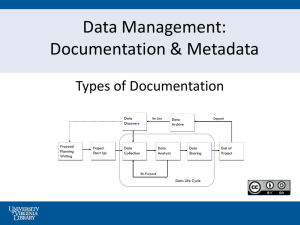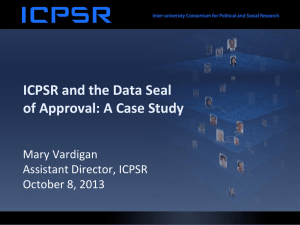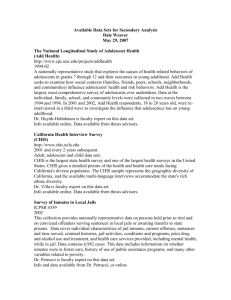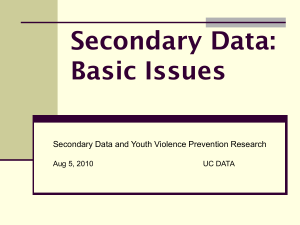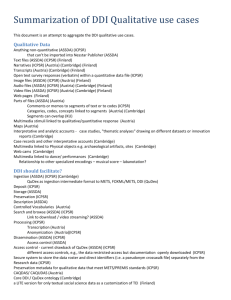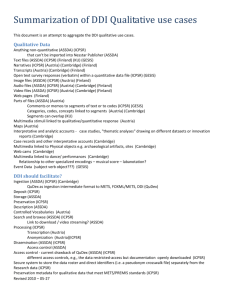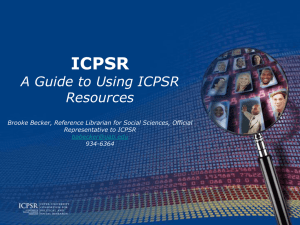5_ICPSR DSA Conference Florence 2012
advertisement
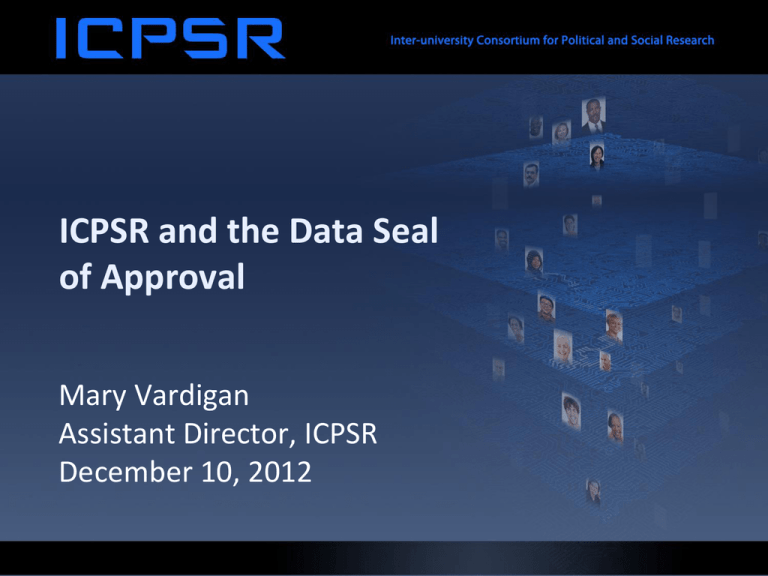
ICPSR and the Data Seal of Approval Mary Vardigan Assistant Director, ICPSR December 10, 2012 Outline of Presentation • What is ICPSR? • Repository assessments undertaken at ICPSR – Test audit – TRAC self-assessment – Data Seal of Approval • Process, effort, findings for each • Conclusions What is ICPSR? • Repository of social science data established in 1962 for data sharing and preservation • Membership-based organization -- over 700 institutional members (colleges and universities) from around the world • Source for training in statistics and data curation through the Summer Program Mission ICPSR provides leadership and training in data access, curation, and methods of analysis for a diverse and expanding social science research community. First Assessment Effort, 2005-2006 • Center for Research Libraries proposed a test audit of ICPSR, along with Koninklijke Bibliotheek National Library of the Netherlands, Portico, and LOCKSS • Purpose: To test a methodology based on the RLG-NARA Checklist for the Certification of Trusted Digital Repositories • Precursor to current TRAC audit/certification processes • ICPSR Test Audit Report: http://www.crl.edu/sites/default/files/attachments/pages /ICPSR_final.pdf Evaluation Criteria • Characteristics of the organization that might affect performance, accountability, business continuity • Technologies and infrastructure employed • Preservation processes and procedures Effort and Resources Required • Completion of Audit Checklist • Gathering of large amounts of data about the organization – staffing, finances, digital assets, process, technology, security, redundancy, etc. • Hosting of audit group for two and a half days with interviews and meetings • Remediation of problems discovered Findings • Taken as a whole, ICPSR appears to provide responsible stewardship of the valuable research resources in its custody. Depositors of data to the ICPSR data archives and users of those archives can be confident about the state of its operation, and the processes, procedures, technologies, and technical infrastructure employed by the organization. Findings (continued) • Succession and disaster plans needed • Funding uncertainty (grants) • Acquisition of preservation rights from depositors • Need for more process and procedural documentation related to preservation • Machine-room issues noted Changes Made • Hired a Digital Preservation Officer • Created policies, including Digital Preservation Policy Framework, Access Policy Framework, and Disaster Plan • Changed deposit process to be explicit about ICPSR’s right to preserve content • Continued to diversify funding (ongoing) • Made changes to machine room TRAC Self-Assessment, 2010-present • Parceled out the 80+ TRAC requirements to committees across the organization • Gathered evidence demonstrating compliance for each guideline • Rated compliance on 0-4 scale • Digital Preservation Officer and Director of Curation Services reviewing evidence • Goal is to provide a report Effort and Resources Required • Time of many individuals across the organization • Technology – Developed Drupal site for data entry • Time for high-level review and summarization • Time/technology most likely required to address areas for improvement DSA Self-Assessment, 2009-2010 http://assessment.datasealofapproval.org/assessment_78/seal/pdf Procedures Followed • Digital Preservation Officer and Director of Collection Delivery conducted the selfassessment, assembled the evidence, and wrote response • Attempted to provide a URL for each guideline • First peer review done offline with no manual to clarify intent of guidelines; second done using online tool – assessment modified Effort and Resources Required • Mainly time of the Digital Preservation Officer and Director of Collection Delivery • Would estimate two days at most • Note: Next self-assessment should be more robust with greater amount of detail Self-Assessment Ratings • Using the manual and guiding questions: Rated ICPSR as having achieved 4 stars for all but Guideline 13, full OAIS compliance Example of Evidence – Guideline 5 • Reviewer stated: I would like to stipulate that this description addresses well the extended criteria of Guideline 5 • Guideline Text: The data repository uses due diligence to ensure compliance with legal regulations and contracts including, when applicable, regulations governing the protection of human subjects. Evidence ICPSR is legally considered a part of the University of Michigan. The primary legal contracts/regulations that ICPSR handles are the Membership Form, Deposit Form, Terms of Use, and Restricted-Use Contracts. The Membership Form specifies responsible use of ICPSR data resources and prohibits the redistribution of data. The ICPSR Deposit Form stipulates that the depositor must have copyright in order to transfer to ICPSR the right to disseminate the data and obtains permission from the depositor for ICPSR to manage the data for purposes of distribution and preservation. ICPSR Terms of Use specify that data may not be redistributed and that users must not disclose the identities of research participants. The Terms of Use include information on penalties for noncompliance. ICPSR’s Restricted-use Contracts are agreements governing the use and protection of data that carry a risk of disclosure. These contracts use model language and are reviewed by legal counsel. Evidence (continued) ICPSR offers three levels of access to data: public-use, restricted-use available via contract, and restricted-use available only onsite at ICPSR under secure conditions. All data are reviewed for disclosure risk and, when necessary, modified in consultation with the investigator. ICPSR is in the process of implementing software that will provide a secure virtual data enclave for individuals using confidential data to ensure that they are in compliance with disclosure risk protocols. ICPSR staff are trained and certified in handling restricted-use data. Data are deposited and processed in a secure nonnetworked environment. Confidential data are stored in encrypted form in multiple locations. Evidence (continued) With respect to compliance with national laws under which ICPSR operates, in the United States there are several statutes and codes related to the privacy and protection of research participants. Of particular note is the federal regulation on Protection of Human Subjects (45 CFR 46). Institutions bear the responsibility for compliance with 45 CFR 46. Every university must file an “assurance of compliance” with the Office for Human Research Protections which includes “a statement of ethical principles to be followed in protecting human subjects of research.” University Institutional Review Boards (IRBs) review research to address these issues. Other relevant U.S. laws include the Family Educational Rights and Privacy Act (FERPA) and the Health Insurance Portability and Accountability Act (HIPAA). ICPSR requests from depositors copies of IRB approval, approved protocols, privacy certificates, and blank consent forms. Evidence (continued) Links provided to: • ICPSR Deposit Form • Terms of Use • Restricted Data Agreement Findings and Changes Made • Recognized need to make policies more public – e.g., static and linkable Terms of Use (previously only dynamic) • Reinforced work on succession planning – now integrated into Data-PASS partnership agreement • Underscored need to comply with OAIS – now building a new system based on it Comparison – Effort and Resources • Test audit was the most labor- and timeintensive • TRAC self-assessment involved the time of more people • Data Seal of Approval least costly Comparison – Changes Made • Test audit was first experience – resulted in greatest number of changes made and greatest increase in awareness • Fewer changes made as a result of DSA assessment because many addressed in earlier test audit; also not as detailed • TRAC assessment will surface additional issues to address Other Observations about DSA • Assessment is a static document -- URLs may change and links may break • Best not to integrate details about technology that may change • Organizations may want to establish a schedule to review their assessments (in addition to DSA prompts) Conclusions: Benefits of DSA Approach • Lower bar, less “threatening“ • Less labor- and time-intensive, less costly • Emphasis on raising awareness and transparency is great • More community- and peer-based rather than top down • Interaction with peer reviewer is meaningful • Seal carries meaning that is easily recognized Thank you! Questions? vardigan@umich.edu
